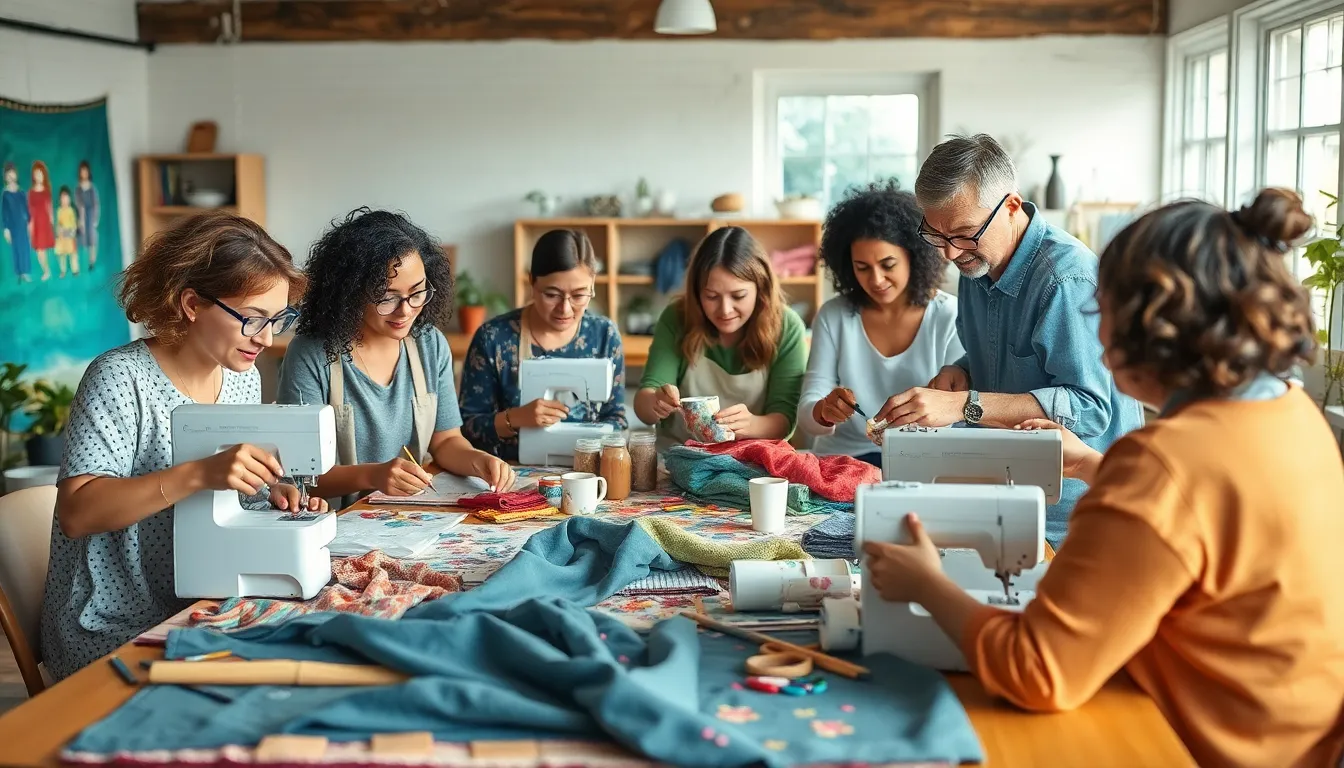Fabric crafts offer a vibrant and creative outlet for anyone looking to explore their artistic side. From quilting to sewing and embroidery, these crafts transform simple textiles into stunning works of art. Whether it’s a cozy blanket or a delicate wall hanging, each project tells a unique story and adds a personal touch to any space.
With the rise of sustainable living and DIY culture, fabric crafts have gained popularity among crafters of all ages. They provide an opportunity to repurpose old materials while fostering creativity and mindfulness. As people seek to connect with their hands and create something tangible, fabric crafts stand out as a fulfilling and enjoyable way to express individuality.
Table of Contents
ToggleOverview of Fabric Crafts
Fabric crafts encompass a broad range of artistic activities that utilize textiles, allowing for diverse expressions of creativity. Quilting involves stitching together layers of fabric to create intricate patterns and designs. Sewing offers versatility, enabling individuals to construct garments, home decor items, and accessories. Embroidery enhances fabric through decorative stitching, adding personalized touches to various projects.
The increase in sustainable living practices has influenced the popularity of fabric crafts. Crafters repurpose old garments and scraps, minimizing waste and fostering an environmentally-friendly approach. DIY culture encourages exploration, making fabric crafts accessible to all skill levels.
Engagement in fabric crafts provides numerous benefits. Practicing these crafts promotes mindfulness, reduces stress, and enhances fine motor skills. Additionally, fabric crafts create a sense of community as individuals share techniques and collaborate on projects, fostering connections among crafters.
Popular Types of Fabric Crafts

Fabric crafts encompass various techniques that transform textiles into artistic forms. Each craft offers unique opportunities for creativity and expression.
Sewing and Quilting
Sewing involves using a needle and thread to assemble fabric into garments, accessories, or home decor items. Quilting combines multiple layers of fabric, often featuring intricate patterns or designs. Crafters create quilts by stitching together patches, enhancing them with batting for warmth. Both sewing and quilting provide a practical outlet for creativity, allowing individuals to customize their projects with personal fabrics and styles.
Embroidery and Appliqué
Embroidery utilizes decorative stitching to embellish fabric items. Crafters often stitch patterns, images, or text, adding detail to garments and home decor. Appliqué complements embroidery by attaching cut-out shapes to a base fabric, creating layered designs. Both techniques enhance the visual appeal of fabric, making items unique and personalized.
Fabric Painting and Dyeing
Fabric painting involves applying paint specifically designed for textiles, allowing for creative expression on various items. Crafters can create designs using brushes, stencils, or stamps, resulting in colorful artwork on fabric. Dyeing transforms fabric color through various methods, such as tie-dye or batik, offering visually stimulating results. Together, fabric painting and dyeing expand creative possibilities, enabling crafters to explore colors and patterns uniquely.
Tools and Materials Needed
Fabric crafts require specific tools and materials to enhance creativity and ensure successful projects. Understanding these essentials is crucial for any crafter.
Essential Sewing Tools
- Sewing Machine: A basic yet essential tool for efficient stitching. A range of machines exists, from beginner to advanced models, each with unique features.
- Needles: Various types of needles cater to different fabrics and techniques. Common options include universal, ballpoint, and quilting needles.
- Thread: Choosing the right thread is vital. Use cotton thread for woven fabrics and polyester thread for stretch materials.
- Scissors: Fabric scissors, rotary cutters, and pinking shears serve specific purposes. Scissors cut fabric while rotary cutters excel at straight lines.
- Measuring Tools: Essential tools include measuring tapes and rulers to ensure accurate measurements for cutting and sewing.
- Pins and Clips: Pins hold fabric pieces together, while fabric clips provide an alternative that avoids marking delicate fabrics.
- Iron: Pressing seams and fabric pieces improves neatness. A steam iron or a specialized fabric iron is ideal for this task.
Types of Fabrics and Their Uses
- Cotton: Widely used in quilting and garment construction, cotton is breathable and easy to sew. Its versatility makes it a staple in fabric crafts.
- Linen: Known for its strength and absorbency, linen suits clothing and home decor. This fabric wrinkles easily but adds charm to projects.
- Silk: Valued for its luxurious feel and drape, silk is perfect for elegant garments and accessories. However, it requires careful handling due to its delicate nature.
- Fleece: Soft and insulating, fleece is popular for cozy apparel and blankets. Its lack of fraying makes it easy to work with in various projects.
- Canvas: A durable fabric ideal for bags and upholstery, canvas resists wear and tear, making it suitable for everyday items.
- Satin: Often used for formal wear and linings, satin offers a sleek appearance. Crafters must use care when handling to avoid slips during sewing.
- Denim: A sturdy fabric commonly used in clothing, denim is versatile and withstands heavy use, making it ideal for various craft projects.
Benefits of Engaging in Fabric Crafts
Engaging in fabric crafts offers numerous benefits that enhance well-being and creativity.
- Promotes Mindfulness: Fabric crafting requires focus and attention, helping individuals immerse themselves in the present moment. This practice fosters relaxation and mental clarity.
- Reduces Stress: The repetitive motions involved in sewing or quilting create a calming effect, which helps alleviate anxiety and tension.
- Enhances Fine Motor Skills: Manipulating fabrics and working with tools improves dexterity and coordination, which is beneficial for all ages.
- Encourages Creativity: Exploring various fabric crafts allows for individual expression. Crafters can experiment with colors, textures, and designs, leading to unique creations.
- Builds Community: Participating in fabric crafts often involves group activities or classes, fostering connections among crafters. Sharing techniques and collaborating on projects strengthens social bonds.
- Supports Sustainable Practices: By repurposing materials and using scraps, individuals contribute to eco-friendly habits and reduce waste, aligning with a growing movement toward sustainability.
These benefits illustrate how engaging in fabric crafts fosters personal growth and enhances skills while providing a fulfilling creative outlet.
Tips for Beginners in Fabric Crafts
- Select the Right Fabric: Choose fabrics that suit the project. Cotton is ideal for beginners due to its versatility and ease of use.
- Gather Essential Tools: Invest in basic tools, including fabric scissors, measuring tapes, pins, and a sewing machine. These tools facilitate accurate cutting and assembly.
- Start Simple Projects: Begin with easy patterns or kits. A basic tote bag or pillow cover offers a manageable starting point for mastering skills.
- Practice Basic Stitches: Familiarize oneself with essential stitches. Straight stitches and zigzag stitches form the foundation for various projects.
- Learn from Tutorials: Watch online video tutorials or join local workshops. These resources provide guidance and clarity on techniques.
- Use Proper Techniques: Follow sewing best practices, such as back-stitching at the start and end of seams. This technique enhances durability.
- Experiment with Colors and Patterns: Combine different fabrics for creative outcomes. Mixing prints and solid colors adds visual interest.
- Stay Organized: Keep tools and materials neatly arranged. This approach saves time and helps maintain focus during projects.
- Be Patient and Persistent: Accept that mistakes happen. Learning from errors improves confidence and skill over time.
- Join a Craft Community: Engage with other crafters through local groups or online forums. Sharing experiences and tips fosters growth and motivation.
Fabric crafts offer a unique blend of creativity and practicality that resonates with many. They provide a meaningful way for individuals to express their artistic visions while also promoting sustainability and mindfulness. Engaging in these crafts fosters a sense of community and shared experiences among crafters, enriching lives through collaboration and creativity.
As one dives into the world of fabric crafts, the journey is filled with endless possibilities. Whether it’s sewing, quilting, or embroidery, each project brings the chance to learn new skills and create something truly special. Embracing fabric crafts can lead to personal growth and a deeper connection to the art of making.




